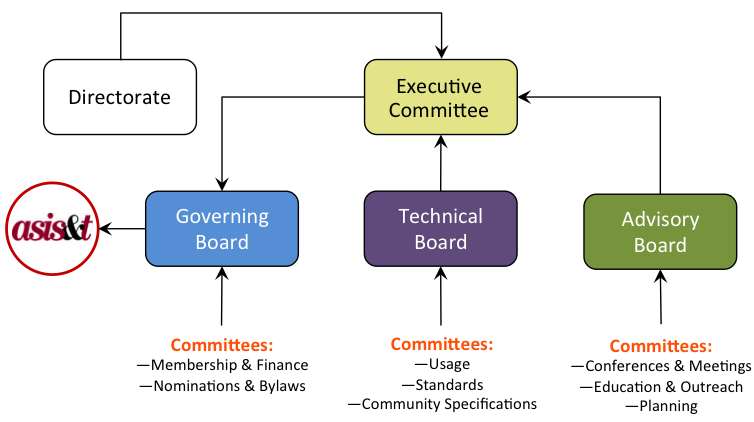QA struct
Contents |
FAQ on the 2014 DCMI Organizational Structure
Questions:
- The management of "specifications" shows up in the charges of both the Technical Board's Usage Committee and its Community Specifications Committee. Which specifications are managed by which body? ANSWER
- Will the new Community Specifications Committee operate under the same policies and procedures as the Usage Board? ANSWER
- Who are the members of the new Executive Committee? ANSWER
- What is the role and the extent of authority of the new Executive Committee? ANSWER
- How has the role of the Directorate changed under the new governance model? ANSWER
- The titular lead of DCMI under the current model is the Managing Director. Who is the titular lead under the new 3-board model? ANSWER
- What is the positioning of the Usage Committee under the new 3-board governance model? ANSWER
- In every organizational governance model, the "buck stops" somewhere? In this 3-board model, with which body does the "buck stop"? ANSWER
- What is meant by "deferential review"? ANSWER
Answers
- The management of "specifications" shows up in the charges of both the Technical Board's Usage Committee and its Community Specifications Committee. Which specifications are managed by which body?
- ANSWER: The Usage Committee's jurisdiction is very similar to the jurisdiction of the old Usage Board with a focus on "technical specifications to which DCMI, as an organization, makes a long-term maintenance commitment". The Community Specifications Committee is intended to provide assistance and a useful path to publication for specifications that come up through DCMI Communities and Task Groups that may or may not ever be the subject of Usage Committee review but that nevertheless deserve a means whereby the DCMI persistence policies make it possible for Community Specifications to be reviewed for best practices by the Community Specifications Committee, published, referenced, and most important, used. In addition, the Community Specifications Committee will develop lightweight, expedited means for what used to be called DCMI Recommended Resources to be proposed and moved forward as DCMI Community Resource.
-
- Will the new Community Specifications Committee operate under the same policies and procedures as the old Usage Board or the new Usage Committee?
- ANSWER: No, policies and procedures appropriate to the circumstances will be developed. However, there will be an Initiative-wide expectation that the processes developed and the criteria applied in advancing a proposed Community Specification will be principled without placing any undue burden on getting specifications published that are deemed useful by the community of use.
-
- Who are the members of the new Executive Committee?
- ANSWER: Membership is comprised of the chairs and chairs-elect of the Governing and Advisory boards and of the co-chairs of the Technical Board. These six members are joined by one member of the Directorate sitting ex officio. The Chair of the Governing Board shall chair the Executive Committee.
-
- What is the role and the extent of authority of the new Executive Committee?
- ANSWER: The six members of the Executive Committee have representative authority from their various boards to act in all ministerial matters regarding the daily operation of DCMI and to make decisions in cases where there is insufficient time for referral of the matter back to the boards for consideration. The members have discretionary authority in subjective, noncontroversial matters; and, they are expected to refer controversial matters back to the boards for deliberations befitting the board charges.
-
- How has the role of the Directorate changed under the new governance model?
- ANSWER: The function of Directorate personnel will shift from shaping the framework of decision-making to more ministerial set of functions focused on the daily operations of DCMI and support for the boards and committees. Many of the former discretionary duties of the Directorate are pushed down to the board and standing committee chairs in general and the Governing Board in particular. The roles and titles of Directorate personnel will be determined from time-to-time by the Governing Board and will vary depending on the needs and resources of the Initiative.
-
- The titular lead of DCMI under the current model was the Managing Director. Who is the titular lead under the new 3-board model?
- ANSWER: The Chair of the Governing Board is the titular lead and authoritative public voice of DCMI.
-
- What is the positioning of the Usage Committee under the new 3-board governance model?
- ANSWER: The former Usage Board was positioned directly under the Directorate and chaired by a member of the Directorate. The Usage Committee reconstitutes the Usage Board as a committee of the new Technical Board. The Usage Committee is co-equal in terms of position with the Standards Committee and the Community Specifications Committee.
-
- In every organizational governance model, the "buck stops" somewhere? In this 3-board model, with which body does the "buck stop"?
- ANSWER: The Governing Board is where the "buck stops". The members of the Board hold a fiduciary relationship to DCMI and will exercise fiduciary authority and oversight over DCMI. The Governing Board Chair reports to ASIS&T.
-
- What is meant by "deferential review"?
- ANSWER: Deferential review is a means for "lowering the center of gravity" on decision making within DCMI. In the DCMI context, it means that a decision by a committee or a board is reviewed in a manner that defers to the initial deciders absent some clear problem in the criteria applied or the process used in reaching the initial decision. In this sense, the reviewing body does not review the substance of the decision anew, but rather "defers" to the judgment of the original deciders.
-
